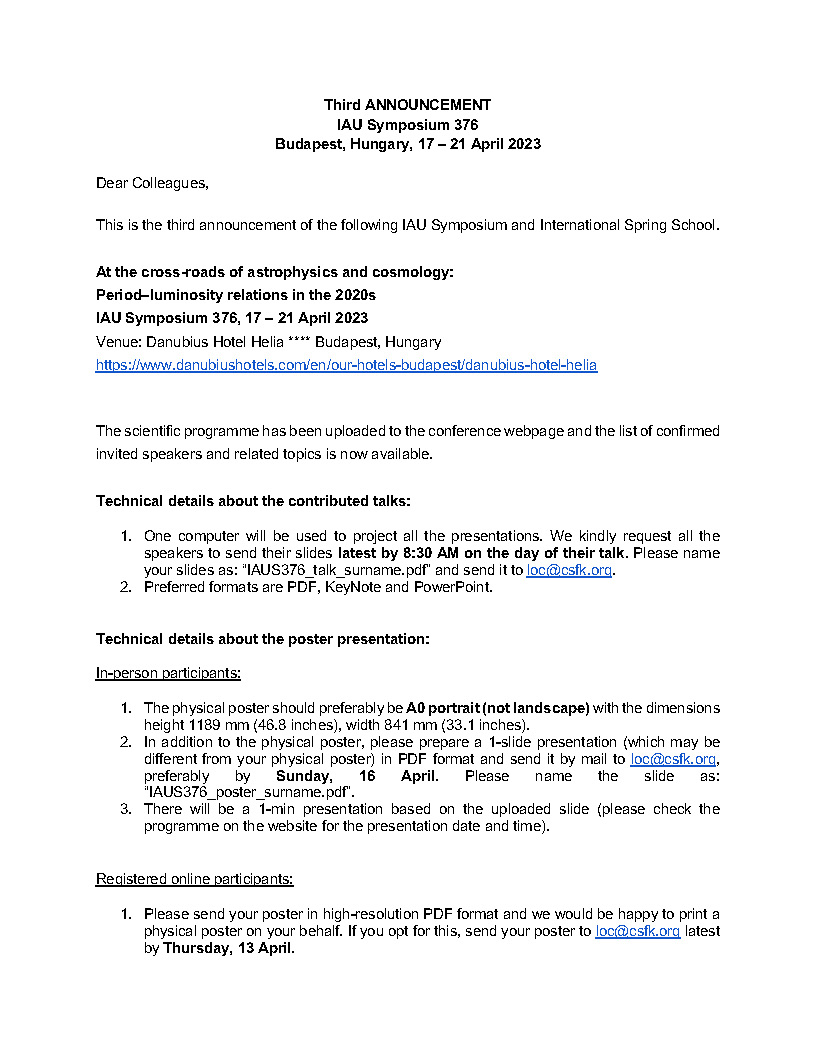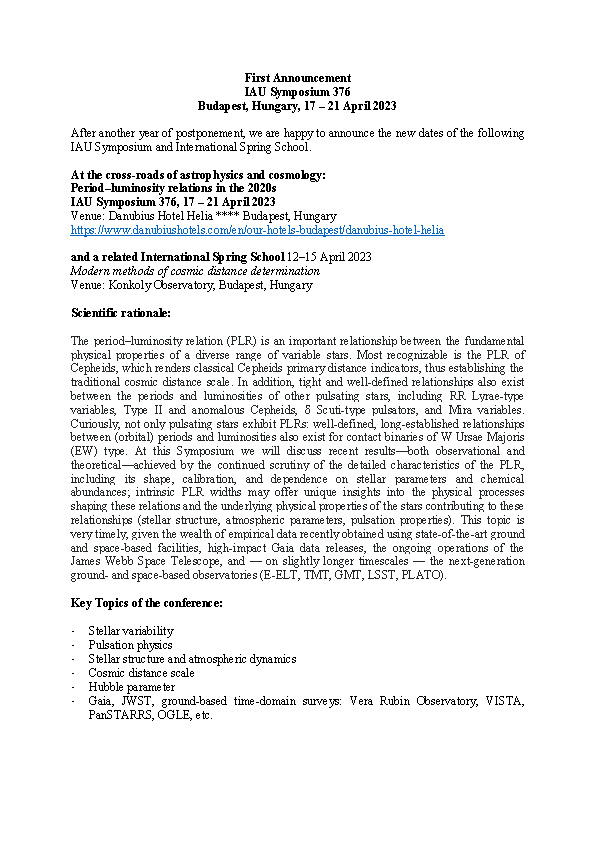
IAU Symposium 376 | 17-21 April 2023
At the cross-roads of astrophysics and cosmology: Period–luminosity relations in the 2020s
An event sponsored by IAU | hybrid conference in Budapest, Hungary
Call for Abstracts
Important dates!
Oral Abstract submission deadline: 27 February 2023.
Poster Abstract submission deadline: 15 March 2023.
Key Topics
- Stellar variability
- Pulsation physics
- Stellar structure and atmospheric dynamics
- Cosmic distance scale
- Hubble parameter
- Gaia, JWST, Vera Rubin Observatory, ground-based time-domain surveys (VISTA, PanStarrs, etc.)
Abstracts should be prepared and submitted according to the instructions below:
- Language of the submitted abstract: English
- Title of abstract
- Full name of author(s), (Please write the full name for all co-authors, do not use initials)
- Affiliation of author(s)
- In case of multiple authors / affiliations, please use index numbers in superscript
- The maximum length of the summary is one A/4 page
- MS Word file (.doc/.docx), Times New Roman font type, 12 pts font size, single line spacing required
- The files should not contain headers or footers
- Abstract template
Objectives
In the early 1900s, Henrietta Leavitt (1908)—and later Adams and Joy (1927) and Shapley and Walton (1927)—showed that bright Cepheid variables were characterized by a narrow range in spectral type or, equivalently, temperature at a given period. This, in turn, led to the establishment of a tight period–luminosity relation (PLR): more luminous stars are expected to have longer pulsation periods. The spectral-type/temperature restriction of Cepheids naturally led to the realization that pulsating variables only occur in a narrow “instability strip” in the Hertzsprung–Russell diagram.
Stellar physics: The instability strip is host to a range of periodic variable stars, including classical Cepheids (δ Cephei stars), Mira variables at the top of the asymptotic giant branch, W Virginis stars (intermediate-mass horizontal-branch stars; “Population II” Cepheids), and RR Lyrae stars. SX Phoenicis and δ Scuti variables (jointly known as dwarf Cepheids or ultra-short-period variables) as well as anomalous Cepheids, and ZZ Ceti, V777 Herculis, and GW Virginis pulsating white dwarfs are also found in the instability strip. All of these stellar types obey specific period–density relations. Curiously, not only pulsating stars exhibit PLRs: well-defined and long-established relationships between orbital periods and luminosities also exist for contact binaries of W Ursa Majoris (EW) type. Crucial remaining open issues in this broad field include the metallicity dependence of the zero point of the Cepheid PLR, the possible presence of a break at a pulsation period around 10 days, and the effects of binarity and circumstellar envelopes. Intrinsic PLR widths may offer unique insights into the physical processes shaping these relations and the underlying physical properties of the contributing stars (stellar structure, atmospheric parameters, and pulsation properties).
Distance tracers: A promising approach to reducing the current systematic uncertainties associated with the present-day expansion rate of the Universe—the well-known tension in the Hubble parameter—is by trying to achieve improved local calibrations of primary distance indicators and their derivatives, including calibration of the photometric zero point of the Cepheid PLR, at both optical and—potentially with much reduced scatter—infrared wavelengths (e.g., starting from existing Spitzer data), for instance through trigonometric-parallax measurements of carefully selected Cepheid samples by Gaia. Improvements in the Cepheid and Mira distance scales will be achievable to a level of 3–4% or better, based on forthcoming mid-infrared observations with the James Webb Space Telescope. Perhaps the most powerful use of the variety of PLRs present for variable stars is the ability to cross-check results from any individual technique. The diverse range of stellar types exhibiting PLRs are drawn from distinct stellar populations, with their own age and metallicity distributions. Working together, these techniques can explore population-based systematics in distance determination to provide insights into potential calibration biases in the current Type Ia supernovae calibration.
Timeliness: Given the success of Gaia EDR3, this Symposium is indeed an opportune time for a comprehensive, high-level IAU Symposium on PLR relations, their impact on cosmological inference, and the insights into fundamental stellar pulsation physics the community can gain from the wealth of recent and ongoing variability studies. With the impending launch of the James Webb Space Telescope on the near horizon, this is the right time to discuss community efforts to make the most of this new opportunity in stellar pulsation physics, in particular how to broaden physical insights into the infrared. In parallel, a range of current and proposed efforts, including recently completed photometric surveys undertaken with the Kepler Space Telescope, the ongoing TESS mission, the ESO/VISTA telescope (VVV, VMC), and aided by the Vera Rubin Observatory in particular, will find enormous numbers of variable stars in resolved stellar systems, offering unique insights into very different populations and generate new interest in variable stars as probes of galaxy structure and windows into stellar evolution. Follow-up spectroscopic surveys of (in particular but not exclusively) Cepheids and RR Lyrae using, e.g., WEAVE, 4MOST, and the Maunakea Spectroscopic Explorer, will soon come online, so this is indeed an opportune time to focus on significantly improving our understanding of the physical attributes of the key variable star populations in the nearby universe.




